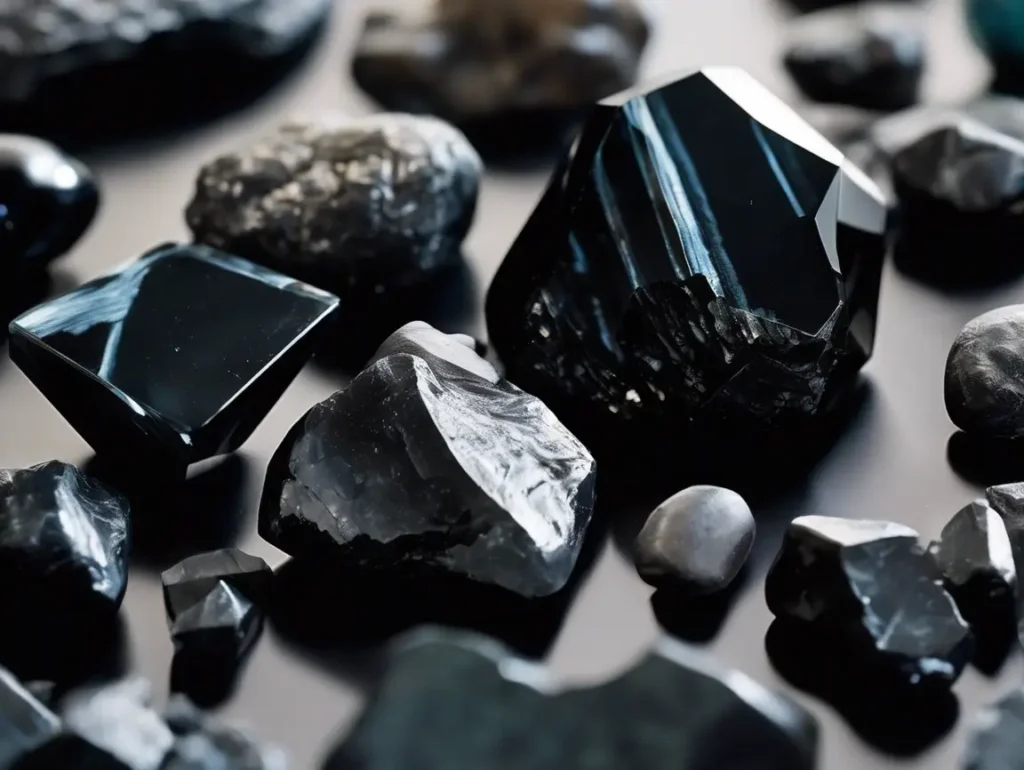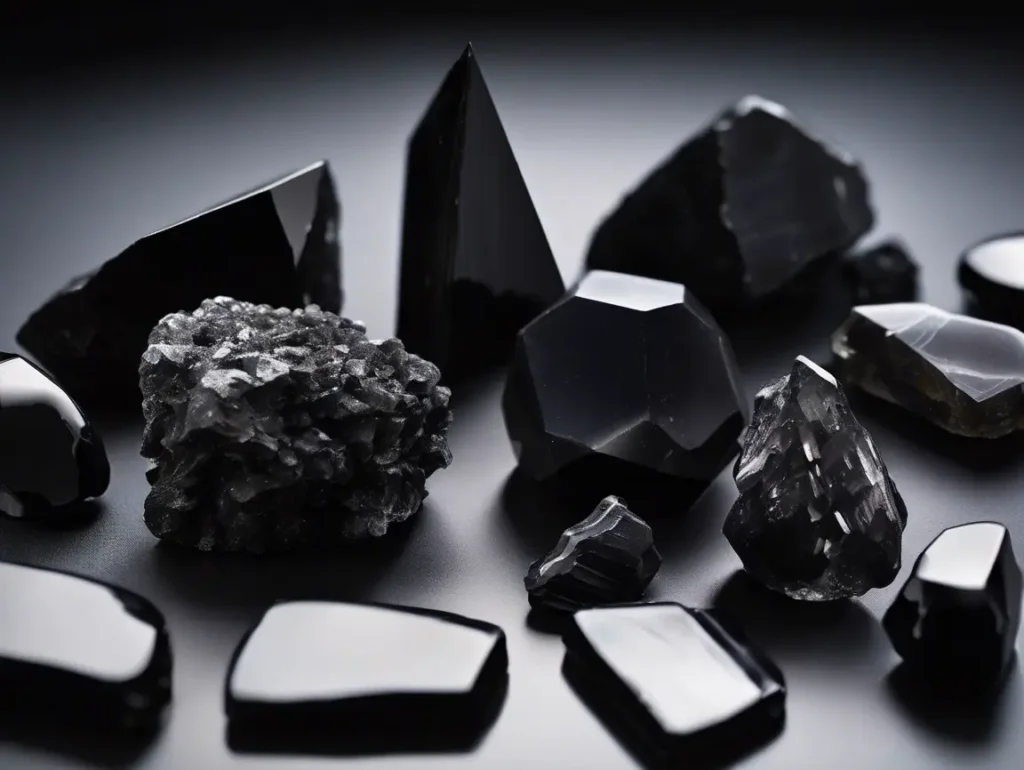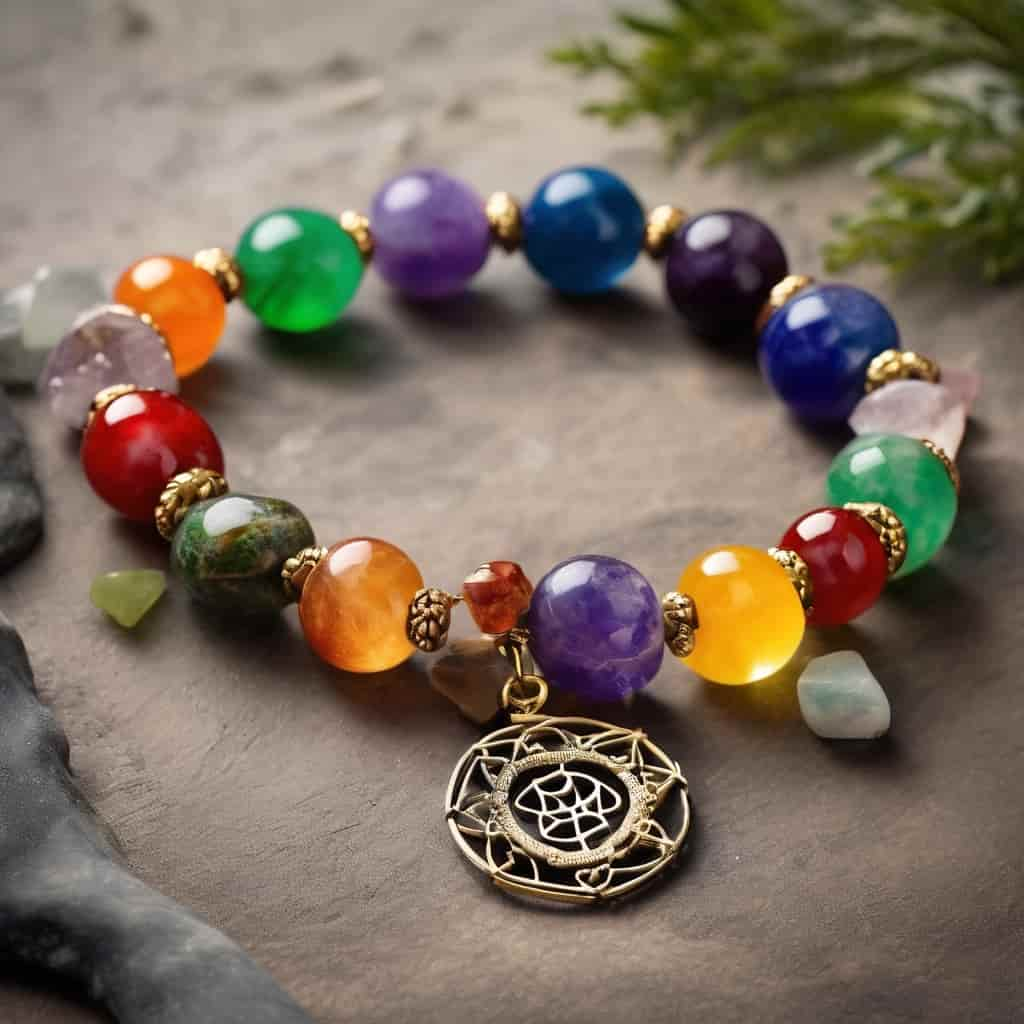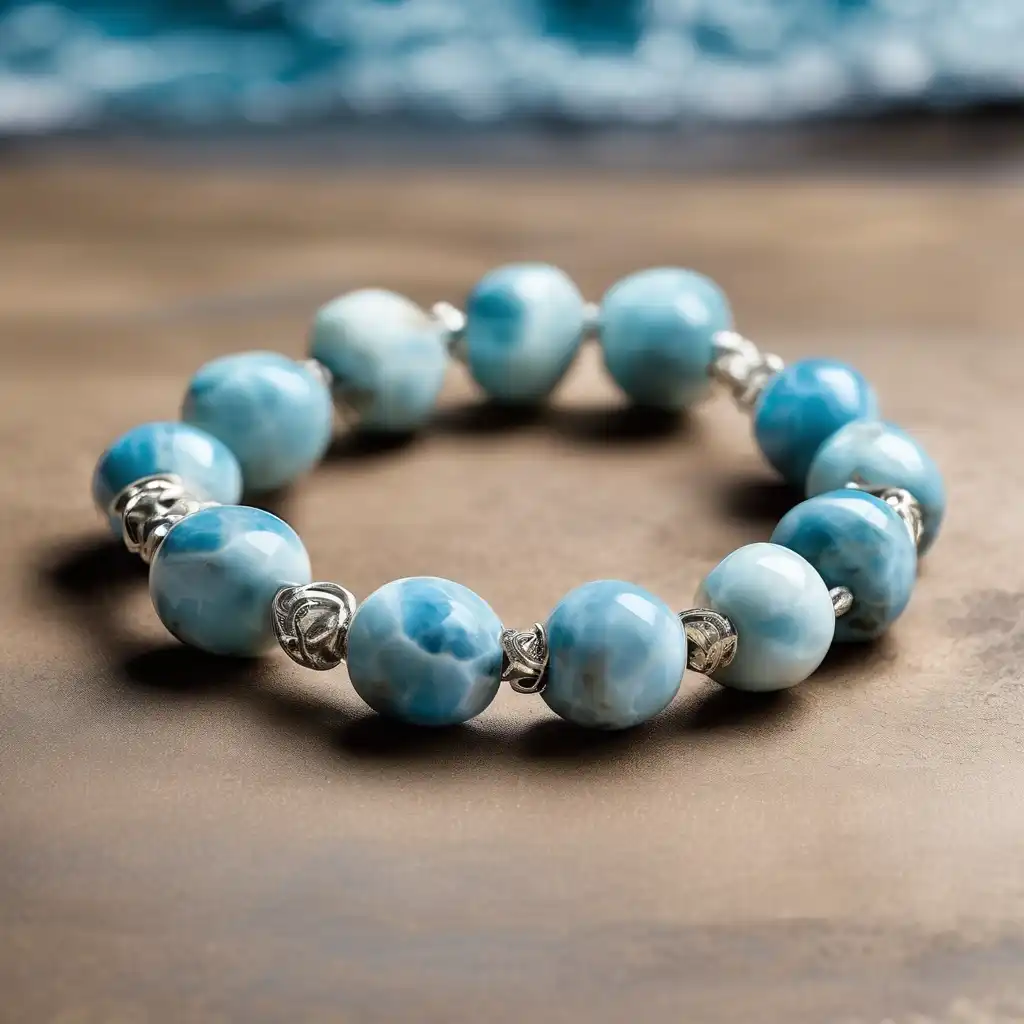Black Obsidian vs Black Tourmaline – A Complete Comparison of Meaning, Power, and Use
Black Obsidian vs Black Tourmaline – Origins, Appearance, and Raw Stone Characteristics
Geological Formation and Origins
When exploring black obsidian vs black tourmaline, one of the most fundamental differences lies in how each stone is formed. Though both are known for their protective energies, they originate from vastly different geological processes, which directly shape their appearance and texture.
Black obsidian is technically not a crystal, but rather volcanic glass formed when molten lava cools rapidly. This sudden cooling prevents crystal structures from forming, resulting in a smooth, glassy texture. Raw black obsidian often resembles broken bottle glass—sharp, shiny, and reflective. These jagged edges were once used by ancient civilizations to craft cutting tools and weapons due to their surgical precision.
In contrast, black tourmaline is a true crystalline mineral formed deep within the Earth. It typically appears more rugged, fibrous, and matte, sometimes resembling chunks of coal. Tourmaline’s surface often features natural striations and lines running along its body. Interestingly, when gently tapped with a hammer, raw black tourmaline may flake or release fine dust—a result of its more brittle crystalline structure. These geological contrasts immediately distinguish black obsidian vs black tourmaline to the trained eye.
Raw Appearance and Size Differences
Visually, the two stones couldn’t be more different when examined in their raw state. Black obsidian has a smooth and shiny exterior, while black tourmaline tends to look rough and weathered. Tourmaline often features surface grooves or what look like tiny blade marks—an appearance many crystal lovers associate with strength and energetic resilience.
In terms of product sizing, both stones are available in various dimensions such as 2–3cm, 3–5cm, and 5–7cm. These sizes are especially popular with Western buyers who prefer using raw stones as part of their spiritual practice or home decor. For example, we’ve had many customers in Europe and North America who display 5–7cm raw pieces in wooden gift boxes, often accompanied by soft ambient lighting to enhance the visual effect. It turns a raw crystal into a powerful yet elegant energy piece.
Weight, Texture, and Grading Explained
When comparing black obsidian vs black tourmaline, another key distinction is in their weight and grading. Although both stones can be processed into polished forms, black tourmaline is significantly denser than obsidian. When held side by side in the same size—say, 6mm or 8mm beads—the tourmaline feels heavier, providing a grounding, solid sensation. Obsidian, by contrast, feels lighter, but with a subtle intensity that some describe as emotionally penetrating.
Grading also plays a major role in visual quality. Black tourmaline in AB grade often retains a coarse texture with visible “cut lines,” while A-grade tourmaline tends to be smoother, sometimes resembling black spinel, though it’s not as reflective. On the obsidian side, grading is often based on color uniformity and the presence of “rainbow eyes”—rare optical effects found in higher-grade material. A-grade black obsidian often shows dual rainbow flashes even without light, while AB+ grade may require a flashlight to reveal its iridescence.
Both stones are frequently carved into beads ranging from 2mm to 12mm. Customers often ask which is more suitable for bracelets. While both are viable, tourmaline provides a denser, more grounding feel, whereas obsidian offers a sleek, emotionally soothing experience. These subtle yet important differences make the comparison of black obsidian vs black tourmaline more than just aesthetic—it becomes a question of energetic preference and personal resonance.
Energy Properties and Spiritual Uses
The Spiritual Meaning of Black Obsidian
One of the most powerful aspects of comparing black obsidian vs black tourmaline lies in understanding how their energies work. Though both are known for their protective qualities, the way they interact with the mind and spirit is quite different.
Black obsidian is a deeply introspective stone. It’s often called the “mirror of the soul” because of its ability to expose hidden truths and suppressed emotions. This volcanic glass doesn’t offer gentle healing—it dives straight into your emotional core. Crystal practitioners commonly recommend black obsidian to those undergoing transformation, healing from trauma, or navigating emotional release.
Many users describe black obsidian’s energy as intense and purifying. It brings unresolved feelings to the surface and forces reflection. In the context of black obsidian vs black tourmaline, obsidian acts as an emotional excavator, helping you let go of the past and see clearly into yourself.
The Protective Nature of Black Tourmaline
Black tourmaline, on the other hand, offers a different kind of support. Where obsidian heals by revealing, tourmaline protects by deflecting. It’s widely known as one of the best stones for grounding and energetic shielding.
Many people wear black tourmaline to protect themselves from electromagnetic fields (EMFs), emotional toxicity, and psychic disturbances. Its energy is steady, supportive, and secure—perfect for daily use. In the debate of black obsidian vs black tourmaline, tourmaline stands out as the reliable bodyguard.
Those working in high-stress environments, crowded public spaces, or digital-heavy offices often use tourmaline near their electronics or wear it in bead form. It keeps their energy field clear and intact, without triggering deep emotional release the way obsidian sometimes can.
Tourmaline’s protective field doesn’t require deep emotional processing, making it ideal for empaths, healers, or anyone who feels energetically “open” to the world around them.
Can You Use Black Obsidian and Tourmaline Together?
Yes—and for many, using both stones together is a powerful combination. Instead of viewing black obsidian vs black tourmaline as opposing forces, think of them as complementary tools.
Black tourmaline serves as a shield, while black obsidian works like a sword—cutting through illusions and clearing what no longer serves you. Together, they offer both defense and release.
Some practitioners place tourmaline at their feet during meditation to stay grounded while holding obsidian in their hands to engage in emotional exploration. Others alternate between the two based on what their energy needs that day.
In our product experience, bundles that include both stones—such as a 5–7cm black tourmaline tower and a polished obsidian sphere—are popular with customers who want a complete energetic toolkit. These bundles are often displayed in wooden boxes with soft lighting, used in personal rituals, or kept on desks and altars.
Still, it’s important to approach the combination mindfully. For beginners or those sensitive to crystal energy, we recommend starting with black tourmaline before gradually introducing black obsidian. The combination can be powerful—but only when your emotional state is ready for what obsidian may bring up.
So, when comparing black obsidian vs black tourmaline, don’t ask which is better. Ask which one serves your purpose right now—and how they might work together to protect and empower your energy.
Jewelry Forms – Beads, Bracelets, and Weight Differences
Black Obsidian vs Black Tourmaline in Bead Jewelry

One of the most common ways people encounter these two stones is through jewelry. In the comparison of black obsidian vs black tourmaline, bead form reveals some of their most practical differences—especially in weight, texture, and visual appeal.
Beads made from black obsidian are smooth, glassy, and highly reflective. Their surface shines like polished glass, offering a sleek and elegant look that appeals to both men and women. Obsidian is often favored in more refined bracelet designs because of its uniform appearance and lightweight feel.
In contrast, black tourmaline beads are typically matte, rugged, and slightly uneven. They often feature natural grooves or lines that give the beads a raw, earthy feel. This texture is part of what makes tourmaline so visually distinctive. Many crystal users say it looks like it has been “battle-tested,” which symbolizes resilience and energetic strength.
When comparing black obsidian vs black tourmaline in jewelry, the weight difference is one of the most noticeable aspects. Tourmaline is significantly denser. If you hold two bracelets of the same size—say 10mm beads—you’ll immediately feel that the tourmaline bracelet is heavier and more grounding. Obsidian, by contrast, feels lighter and smoother, offering a different kind of comfort.
Visual Similarities and Common Confusions
A frequent challenge in the world of gemstone jewelry is telling similar-looking stones apart. In the case of black obsidian vs black tourmaline, this is especially true with polished beads.
Black obsidian is often mistaken for black agate or black onyx because of its glossy surface. When polished, it reflects light beautifully and looks nearly identical to these other black stones. Without proper labeling, customers may not realize what they’re holding is volcanic glass, not crystalline quartz or chalcedony.
Black tourmaline, especially in A-grade quality, can resemble black spinel—a heavier, more brilliant gemstone used in high-end jewelry. But spinel is smoother, denser, and more lustrous. In comparison, even high-grade tourmaline retains a slightly natural, unfinished feel, which is part of its charm.
To help customers navigate black obsidian vs black tourmaline, we often display bead samples side by side. This makes it easier to feel the difference in weight and spot subtle textural cues. Tourmaline may have tiny fractures or blade-like marks, while obsidian maintains a sleek, uninterrupted surface.
We also educate customers on the different finishes and grades—A vs AB vs AB+—so they understand how pricing, appearance, and energy quality all align.
Cultural Preferences and Market Trends
In global markets, preferences for black obsidian vs black tourmaline vary significantly by region and cultural context.
European and American buyers tend to prefer black tourmaline in raw, chunky, or minimally processed styles. Its heavy feel and rugged look make it a favorite for grounding and masculine energy. It’s often used in yoga studios, meditation accessories, or casual jewelry.
Black obsidian, however, is more popular in Asia and Latin America, where its glossy appearance is associated with clarity, Feng Shui balance, and spiritual cleansing. Obsidian bracelets in 8mm or 10mm are especially popular in these regions, often worn for protection and emotional detox.
An emerging trend is blending both stones in a single bracelet. This offers the best of both worlds—obsidian for emotional clarity and tourmaline for energetic shielding. We’ve seen strong sales in this hybrid design, especially for people who want versatile daily protection.
There’s also a gendered approach: black tourmaline bracelets are frequently marketed as men’s spiritual jewelry due to their weight and texture, while black obsidian is often promoted to women for its elegant, polished finish. This targeted framing works well in eCommerce where product images drive first impressions.
Ultimately, the real magic happens when customers choose the stone that matches their energetic needs, not just their fashion preferences. Whether it’s sleek obsidian or rugged tourmaline, the right choice often comes down to what the wearer is currently going through.
So, when it comes to black obsidian vs black tourmaline in jewelry, it’s less about looks—and more about what energy you want to carry with you every day.
Home Decor and Energy Healing Usage
The Role of Black Stones in Energy Spaces
Beyond personal jewelry, the conversation around black obsidian vs black tourmaline extends into home decor and energy healing. These two powerful stones are not just spiritual tools—they’re design elements that bring intention, grounding, and protection into any living space.
Black tourmaline, with its strong, earthy vibration, is often used to create energetic boundaries within a home. It’s placed near doorways, windows, or electronic devices to shield from unwanted energy and electromagnetic fields (EMFs). The raw, textured look of tourmaline makes it perfect for rustic, grounding interior styles.
Black obsidian, on the other hand, is smooth, reflective, and more introspective in its energy. Many people use obsidian in meditation spaces or bedrooms to support emotional clarity and calm. Its mirror-like surface invites quiet self-reflection, making it ideal for inner healing.
When comparing black obsidian vs black tourmaline in home energy work, the choice often comes down to what you’re trying to shift. Do you want to block external chaos? Tourmaline. Do you want to uncover internal truths? Obsidian.
Sphere vs Tower – Which to Use and Where
In the world of crystal décor, two shapes dominate the use of black obsidian vs black tourmaline: spheres and towers.
Spheres emit energy evenly in all directions. A black obsidian sphere placed on a shelf or meditation altar creates a peaceful, reflective field. It’s commonly used during rituals or full moon ceremonies to release emotional baggage. Its glossy surface enhances visual focus during meditation.
Black tourmaline spheres provide a more stabilizing energy. While less reflective than obsidian, they offer a solid, grounding presence. Clients often place them near their beds, office desks, or entryways to create a steady energetic buffer. The natural heaviness of tourmaline reinforces the sense of security.
Towers, by contrast, project energy upward and outward. Tourmaline towers are frequently placed at the four corners of a room or home to form a protective grid. Their directional energy makes them perfect for focused intention-setting or shielding a physical space.
Obsidian towers, with their pointed structure and polished surface, are often used in spiritual work that requires clarity, emotional release, or psychic protection. They’re especially helpful during meditative introspection or journaling rituals.
So, in the design dialogue of black obsidian vs black tourmaline, spheres create harmony, towers provide direction. And each has its place in an intentional home.
Size, Styling, and Cultural Preferences
Size also plays a role in how black obsidian vs black tourmaline are used for decor. Both stones come in a range of sizes—1cm to 20cm—but the impact varies depending on placement.
For subtle decor, smaller stones (2–5cm) can be tucked into drawers, on bookshelves, or in compact crystal grids. For focal points, larger pieces (10–20cm) stand out as centerpieces or altar anchors. Their presence enhances the room’s energy while adding symbolic weight.
Our Western clients, especially in the USA and Europe, love displaying 5–7cm stones inside finely crafted wooden boxes. Some add ambient lighting under the stones to highlight their texture and create a meditative mood. This fusion of raw crystal energy and aesthetic presentation is both modern and spiritually rooted.
In terms of look and feel, black obsidian blends seamlessly into minimalist or modern spaces due to its glassy finish and clean lines. Black tourmaline, being raw and textural, fits well in earthy, bohemian, or rustic environments.
We’ve had clients set up beautiful dual-stone displays: an obsidian sphere in the meditation zone and a tourmaline tower at the entrance. This layout invites inward exploration while protecting the outer edge of the home—a beautiful example of how black obsidian vs black tourmaline can work in harmony.
Whether you prefer high-polish elegance or raw earthiness, both stones bring power and presence into your space. The key is knowing what you want the energy of that space to do—and choosing the right crystal to help shape it.
Which Is Better, Black Obsidian vs Black Tourmaline?
Understanding the Right Stone for You

When people ask about black obsidian vs black tourmaline, what they often want to know is: which one is better? But in reality, the better question is: which one suits your current energy needs?
Black obsidian is intense and transformational. It’s ideal for those who are working through emotional challenges, shadow work, or moments of inner transformation. This stone cuts through illusions and helps reveal the truth—not just around you, but within you.
Black tourmaline, by contrast, is dependable and grounding. It’s the stone you reach for when you feel energetically vulnerable or overwhelmed. It helps create healthy boundaries, blocks negativity, and keeps your space clear and calm.
When comparing black obsidian vs black tourmaline, it’s helpful to see them as different tools for different jobs. Use obsidian when you’re ready to confront what’s buried deep. Use tourmaline when you need to stay rooted and protected in your daily life.
Some people alternate between the two based on their emotional state. Others wear both as a way to balance release and defense. There’s no right or wrong—only resonance.
Frequently Asked Questions
What is Black Obsidian good for?
Black obsidian is used for emotional clearing, shadow work, truth-seeking, and deep introspection. It’s excellent for people going through personal transformation or those seeking clarity in difficult times.
What does Black Tourmaline do for you?
Black tourmaline protects your energy field by blocking negativity, shielding from EMFs, and grounding your emotions. It’s ideal for sensitive individuals or those in high-stress environments.
Which is better, Black Obsidian vs Black Tourmaline?
It depends on your intention. Choose black obsidian for deep emotional healing and insight. Choose black tourmaline for protection, daily stability, and energy cleansing. Both serve different purposes.
Which zodiac should wear Black Obsidian?
Scorpio, Capricorn, and Sagittarius often resonate with black obsidian. However, anyone going through change or seeking emotional clarity can benefit from its energy.
Who cannot wear Black Obsidian?
Those who are extremely sensitive or emotionally vulnerable may find black obsidian overwhelming. It’s best introduced slowly or used intentionally in short sessions.
Can you use Black Obsidian and Black Tourmaline together?
Yes. Many practitioners combine them for balanced energy work—obsidian for emotional release and tourmaline for protective grounding. They complement each other beautifully when used with intention.
Which is better, Black Onyx or Black Tourmaline?
Black onyx is stabilizing and good for focus, but lacks the shielding strength of tourmaline. If you need protection from negative energy, black tourmaline is the stronger choice.
What two crystals cannot be together?
Crystals like moldavite and black obsidian can be overwhelming if used together due to their intensity. While there are no strict “rules,” it’s best to listen to your body and intuition when combining stones.
What is a Tourmaline stone good for?
Tourmaline is excellent for grounding, EMF protection, stress reduction, and spiritual shielding. It supports the root chakra and reinforces emotional boundaries.
What are the powers of Black Obsidian?
Black obsidian is known for truth, transformation, energetic cleansing, and cutting cords from past trauma. It’s also used in scrying and psychic protection.
Conclusion – Choosing the Right Stone for Your Journey
At the end of the day, the decision between black obsidian vs black tourmaline isn’t about which one is better—it’s about which one aligns with you.
If you’re ready to go deep, uncover truths, and release emotional baggage, black obsidian is your guide. If you’re seeking safety, stability, and energetic protection, black tourmaline is your ally.
Many people find that having both stones on hand allows them to shift with their needs—using obsidian for internal work and tourmaline for daily defense. Whether you’re decorating your home, wearing a bracelet, or meditating with a crystal in your hand, these two stones offer strength in different ways.
So instead of asking which one to choose, consider how they might work together. Because in the journey of healing and growth, black obsidian vs black tourmaline is not a competition—it’s a partnership.




